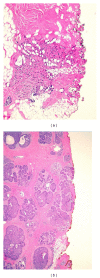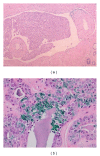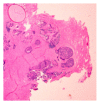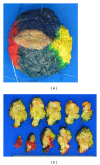Evaluation of resection margins in breast conservation therapy: the pathology perspective-past, present, and future
- PMID: 23213495
- PMCID: PMC3507155
- DOI: 10.1155/2012/180259
Evaluation of resection margins in breast conservation therapy: the pathology perspective-past, present, and future
Abstract
Tumor surgical resection margin status is important for any malignant lesion. When this occurs in conjunction with efforts to preserve or conserve the afflicted organ, these margins become extremely important. With the demonstration of no difference in overall survival between mastectomy versus lumpectomy and radiation for breast carcinoma, there is a definite trend toward smaller resections combined with radiation, constituting "breast-conserving therapy." Tumor-free margins are therefore key to the success of this treatment protocol. We discuss the various aspects of margin status in this setting, from a pathology perspective, incorporating the past and current practices with a brief glimpse of emerging future techniques.
Figures











Similar articles
-
Margin assessment before intraoperative radiotherapy during breast conserving surgery-Does the addition of MarginProbe decrease the need for addition of fractionated whole breast radiation?Breast J. 2020 Jul;26(7):1343-1346. doi: 10.1111/tbj.13865. Epub 2020 May 4. Breast J. 2020. PMID: 32367618
-
A nationwide pathology study on surgical margins and excision volumes after breast-conserving surgery: There is still much to be gained.Breast. 2016 Feb;25:14-21. doi: 10.1016/j.breast.2015.11.003. Epub 2015 Dec 11. Breast. 2016. PMID: 26801411
-
Negative margin status improves local control in conservatively managed breast cancer patients.Cancer J Sci Am. 2000 Jan-Feb;6(1):28-33. Cancer J Sci Am. 2000. PMID: 10696736
-
Close/positive margins after breast-conserving therapy: additional resection or no resection?Breast. 2013 Aug;22 Suppl 2:S115-7. doi: 10.1016/j.breast.2013.07.022. Breast. 2013. PMID: 24074771 Review.
-
Local failure and margin status in early-stage breast carcinoma treated with conservation surgery and radiation therapy.Ann Surg. 1993 Jul;218(1):22-8. doi: 10.1097/00000658-199307000-00005. Ann Surg. 1993. PMID: 8328825 Free PMC article. Review.
Cited by
-
Microfluidics for rapid cytokeratin immunohistochemical staining in frozen sections.Lab Invest. 2017 Aug;97(8):983-991. doi: 10.1038/labinvest.2017.49. Epub 2017 May 29. Lab Invest. 2017. PMID: 28553936 Free PMC article.
-
Nuclear-medicine probes: Where we are and where we are going.Med Phys. 2022 Jul;49(7):4372-4390. doi: 10.1002/mp.15690. Epub 2022 May 20. Med Phys. 2022. PMID: 35526220 Free PMC article. Review.
-
Multivariate analysis of breast tissue using optical parameters extracted from a combined time-resolved fluorescence and diffuse reflectance system for tumor margin detection.J Biomed Opt. 2023 Aug;28(8):085001. doi: 10.1117/1.JBO.28.8.085001. Epub 2023 Aug 23. J Biomed Opt. 2023. PMID: 37621419 Free PMC article.
-
Method for coregistration of optical measurements of breast tissue with histopathology: the importance of accounting for tissue deformations.J Biomed Opt. 2019 Jul;24(7):1-12. doi: 10.1117/1.JBO.24.7.075002. J Biomed Opt. 2019. PMID: 31347338 Free PMC article.
-
Occurrence of Occult Malignancies in Reduction Mammoplasties.Front Surg. 2018 Feb 28;5:17. doi: 10.3389/fsurg.2018.00017. eCollection 2018. Front Surg. 2018. PMID: 29564332 Free PMC article.
References
-
- Fisher B, Anderson S, Bryant J, et al. Twenty-year follow-up of a randomized trial comparing total mastectomy, lumpectomy, and lumpectomy plus irradiation for the treatment of invasive breast cancer. New England Journal of Medicine. 2002;347(16):1233–1241. - PubMed
-
- Veronesi U, Cascinelli N, Mariani L, et al. Twenty-year follow-up of a randomized study comparing breast-conserving surgery with radical mastectomy for early breast cancer. New England Journal of Medicine. 2002;347(16):1227–1232. - PubMed
-
- Van Dongen JA, Voogd AC, Fentiman IS, et al. Long-term results of a randomized trial comparing breast-conserving therapy with mastectomy: European organization for research and treatment of cancer 10801 trial. Journal of the National Cancer Institute. 2000;92(14):1143–1150. - PubMed
-
- Poortmans PM, Collette L, Horiot JC, et al. Impact of the boost dose of 10 Gy versus 26 Gy in patients with early stage breast cancer after a microscopically incomplete lumpectomy: 10-year results of the randomised EORTC boost trial. Radiotherapy and Oncology. 2009;90(1):80–85. - PubMed
-
- Schnitt SJ, Connolly JL, Khettry U. Pathologic findings on re-excision of the primary site in breast cancer patients considered for treatment by primary radiation therapy. Cancer. 1987;59(4):675–681. - PubMed
LinkOut - more resources
Full Text Sources
Miscellaneous

